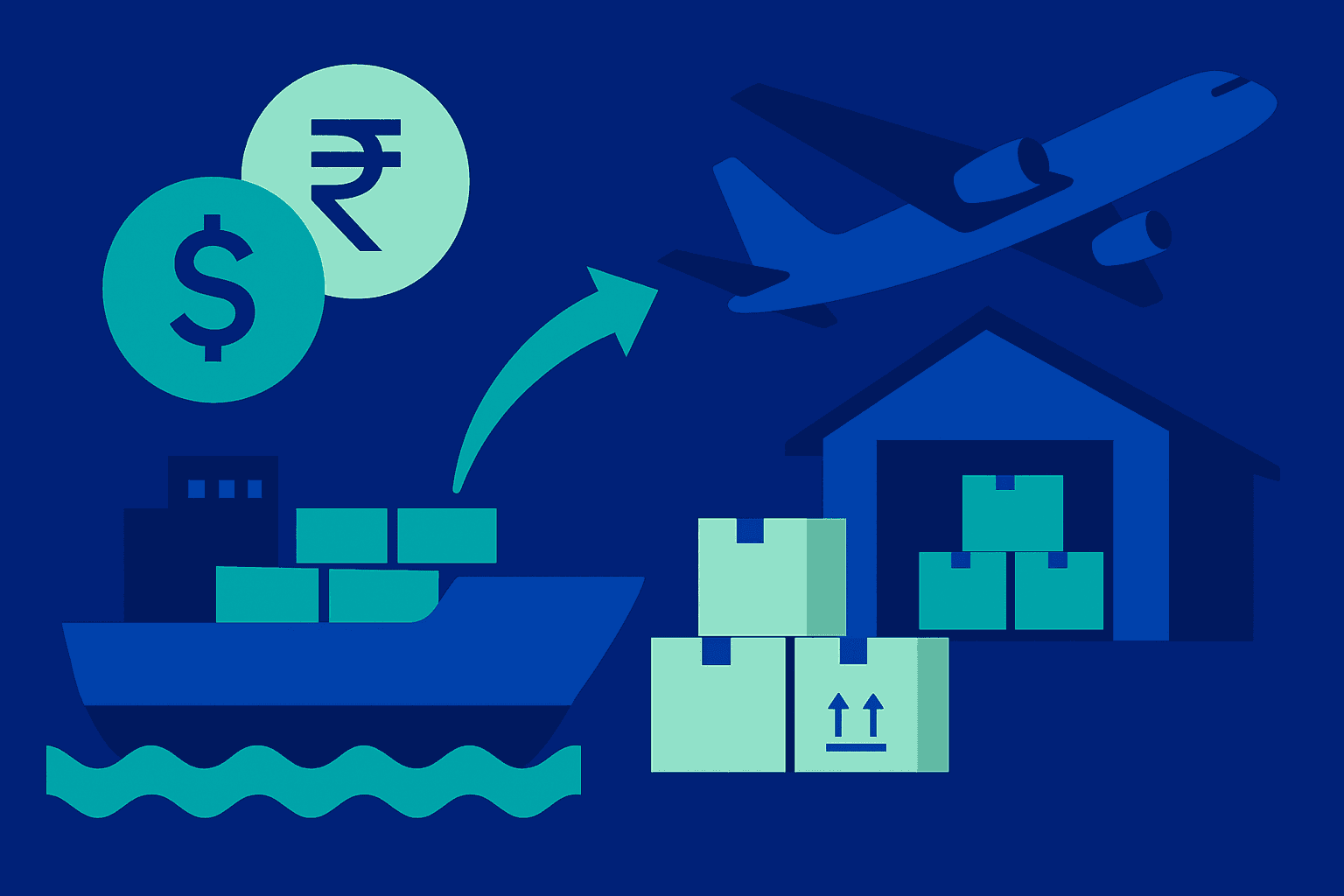Top International Payment Methods in 2025

With the power of the internet, you can work with clients thousands of miles away. However, signing a foreign client is only the first step in growing an international business. Selecting the appropriate international payment methods is crucial for effectively managing and scaling your business. Each method offers unique features, fees, and integration capabilities, so it's essential to choose one that aligns with your business needs.
This blog will be your go-to guide to choosing the right solution as your long-term payment partner. We have identified four of the best international payment methods and analyzed them by highlighting their pros and cons.
Top 4 International Payments Methods in India
India’s service exports grew by 16.5% in 2025, indicating that more small and large businesses and freelancers might expand their business overseas. To help them pick the right payment platform, here are the pros and cons of the four most popular international payment methods.
SWIFT Payments via Banks
SWIFT money transfers are essentially international money transfers that happen via banks. Note that SWIFT is not a bank that holds money. Rather it is a messaging network that banks use to send money across borders. facilitates the movement of funds across borders. SWIFT payment is definitely the most popular international payment method, especially among established and big businesses. But is it the right choice for you? Let's take a quick look at its pros and cons:
Pros of SWIFT Transfers
Safe and Trusted
SWIFT transfers via banks are considered one of the safest and most secure international payment methods, thanks to its robust networking infrastructure and strong protection measures. However, while accepting a payment via SWIFT make sure to share the correct details to avoid any delays or cancellations.
Global Acceptability
Nearly every country and currency is covered under SWIFT making it the most popular and universally accepted international payment method. The advantage is you can work with clients from almost any country without worrying about compatibility
Online Banking Services Making It More Convenient
Most banks offer SWIFT as part of their online banking services. That means you can manage your international transactions from the comfort of your home or office.
Cons of SWIFT Transfers
Longer Settlement Time
The settlement time of a SWIFT transfer can be up to 5 business days or more depending on intermediary banks, holidays etc. For small businesses, such a long settlement time can cause cashflow issues.
Forex Markup and Other Fees
The total fees on SWIFT transfer take a deep cut on the amount you receive. For starters, an average transfer from the US can cost $15-$50, which is mostly passed on to the receiver by the payer.
The receiving bank might also charge an inward remittance fee based on their policy. However, beyond SWIFT fee, banks make the most money via forex markup. Most banks do not provide live forex rates while converting money, instead, they offer you lower exchange rates. For example, if the live forex rate is 1USD = INR 86, banks may offer you 84. So for a payment of USD 5000, you will get INR 4,20,000 (84*5000) instead of INR 4,30,000 (86*5000)
Forex markup coupled with SWIFT fee and other ancillary fees can make SWIFT transfers via banks a rather expensive international payment method
Additional Cost for FIRA
FIRA or Foreign Inward Remittance Advice serves as proof of export income from abroad. Every Indian business or freelancer having foreign income needs to acquire FIRA. Now while banks issue FIRA for every international payment, it is not a default action. You need to request your bank for the same and most banks levy a fee to furnish FIRC. HDFC bank, for example, charges Rs. 200 for issuing a single FIRA.
While bank-mediated SWIFT transfers are a widely used international payment method, their extended settlement times—often ranging from one to five business days—and substantial fees may not suit every business's needs.
Virtual Bank Accounts
Virtual bank accounts are a modern international payment method that is gaining rapid popularity among Indian businesses. Platforms like Skydo offer users virtual bank accounts in countries like the US, UK, and Australia. Clients in these countries can send payments to these virtual accounts as local transfers, avoiding the hassle and cost of international transfers.
The platforms then consolidate these local payments and transfer them to the recipient’s personal bank account. Can virtual bank accounts become your preferred international payment method? Let's find out:
Pros of Virtual Bank Account
Quick Settlement
Virtual accounts are much faster compared to SWIFT in settling transactions. Platforms like Skydo settle a transaction within 24 -48 hours, providing your business with instant liquidity
Cost-efficient
When your client pays you in your virtual bank account, it becomes a local transfer and not an international transfer thereby bypassing the SWIFT fee. However, different platforms offering virtual accounts charge their respective fees. Skydo simply charges USD 19 for payments under USD 2000, USD 29 for payments between USD 2000-10,000 and 0.3% for payments above USD 10,000. That's it. Most importantly, unlike banks and many other international payment methods, Skydo converts your payment at a live forex rate without any markup. If the prevailing exchange rate is 1USD= INR 86, that is the exchange rate you will get, ensuring you keep the maximum of what you get.
Automatic FIRA
Most platforms offering virtual bank accounts also offer FIRA saving you the hassle of following up with banks. Skydo for example offers free and instant FIRA for every transaction, easing your compliance burden.
Secure
Virtual accounts have advanced security features like encryption, multi-factor authentication, and real-time fraud monitoring. Also, if your virtual account number gets compromised, no one can gain access to your bank account
Cons of Virtual Bank Accounts
Cannot Hold Money
Virtual accounts are like delivery agents – they receive money and transfer it to your bank account. They cannot hold it, which might not be preferable for a few businesses
Trust Deficit
Virtual bank accounts are recognized as safe and secure methods for international payments, offering benefits such as reduced fees and faster transactions. However, due to their relatively recent emergence, some international clients may be hesitant to adopt them.
Payment Gateways
Payment gateways are digital intermediaries facilitating payments between you and your client. A payment gateway aggregates different payment methods so you can provide multiple options to your client making it a popular international method, especially for e-commerce businesses. For example, if you’re using a payment gateway like PayPal, you can offer your clients to pay via credit card, debit card or from their PayPal account. The flexibility is convenient for you and your client and simplifies the entire payment process.
Pros of Payment Gateways
High Security
Payment gateways are highly secure for handling sensitive information. They adhere to the guidelines of the Payment Card Industry Data Security Standard (PCI DSS) to protect data like credit card numbers and avoid data breaches.
Easy Integration
Payment gateways can be easily integrated into websites or online stores, allowing any international buyer to make hassle-free payments in their currency, including purchasing a luxury watch from Tissot.
Multiple Options
Payment gateways allow different options to make payments like credit cards, bank transfers or e-wallets based on the user’s preference
Cons of Payment Gateway
High Fees and Costs
Payment gateways charge fees in different categories and can be quite high for small businesses and freelancers. For example, PayPal charges a 4.4% transaction fee, coupled with a fixed fee and 4 currency conversion fee.
Limited Customer Support
The level of customer support varies according to the region. For example, PayPal doesn't have an India-based support team, making it difficult for Indian businesses to get in touch with them.
Customer Experience Issues
Redirecting customers to an external payment gateway during checkout can disrupt the buying experience, leading to potential confusion and security concerns.
Online Remittance Platforms
Online remittance platforms like Western Union, Wise p2p allow anyone to make cross-border payments effortlessly. They are fast, secure, and like payment gateways, they accept multiple payment methods like bank transfers and credit cards. They offer real-time payment tracking and lower fees, making it an affordable international payment method.
Pros of Online Remittance Platforms
Speed and Convenience
Online remittance platforms usually take less time to settle transactions. They are available to use 24/7 and can be done via a mobile app too
Competitive Exchange Rates
These platforms often offer competitive rates compared to banks. Therefore, you get a high value when the amount is converted to domestic currency
Security and Transparency
With real-time tracking, encryption, and fraud detection techniques, online remittance platforms are considered safe for cross-border payments
Cons of Online Remittance Platforms
Technical Issues
In case of a technical failure or server downtime, there might be a delay in payment, causing an inconvenience
Limited Coverage
While remittance platforms are quite popular, they might not be available in certain regions
Hidden Charges
Most remittance platforms are transparent about their fees, however, there still could be hidden charges on currency exchange rates. It’s advisable to do due diligence before choosing the right platform.
Compliance
The convenience and easy-to-use interface of remittance platforms make it a more popular choice for personal transfers. However, it might not be the most apt international payment method for businesses as these platforms mostly don't provide FIRA, making compliance harder for businesses.
Skydo: Your Top International Payment Method in 2025
Virtual accounts are reliable, quick, and hassle-free. Moreover, the fees are affordable, which makes it a perfect fit for emerging businesses and freelancers to grow their international business. If virtual accounts hold the top position in your priority list, you must try Skydo.
With Skydo, you can create virtual accounts in regions like the US, the UK, Singapore, and Australia. After you receive the payment from these regions, Skydo consolidates the payments and transfers them to your bank account within 24 hours, providing quick liquidity.
But it’s often challenging to keep track of clients’ payments; Skydo’s real-time payment tracking feature could help. Send personalized reminders, get updates when the client sees the reminder, and get notifications when the payment status changes from transit to receipt. All of this from a single dashboard.
Skydo also offers live Forex rates, providing you the best value for money and instant FIRA for free to keep your business compliant with RBI regulations. These two points are the biggest highlights that separate Skydo from other platforms including banks.
While cost-effectiveness is Skydo’s plus point, its 5-minute onboarding process and India-based customer support team are the other reasons to make Skydo your international payment partner.
Is Skydo the right solution for your business? Find out with a free demo












